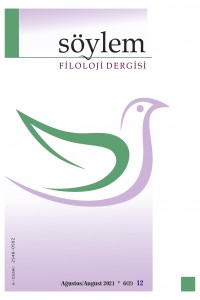Öz
1845 yılında Thomas De Quincey, yayınlamış olduğu “The Palimpsest” adlı makalesinde palimpsest kavramını ve bu kavramın varlığını açıklamaya çalışır. Fakat palimpsest kavramını ilk kullanan De Quincey değildir. Palimpsest, 1845 yılından önce antik dönem el yazmalarını tanımlarken kullanılmıştır. Bu kavramın edebiyata yansımaları hakkında Gerard Genette Palimpsests (1997) ve Sarah Dillon Palimpsest Edebiyat, Eleştiri, Kuram (2017) adlı eserleriyle kuramsal çalışmalar yaparlar. Genette eserinde başmetinsellik, metinlerötesilik ve metinsel aşkınlık kavramlarını açıklamaya çalışırken, Dillon kuramsal çalışmasında De Quincey, Freud, Roland Barthes ve Derrida’nın düşüncelerini irdeleyerek, var olan metinlerin yeni metinler ile yeniden hayat bulup dirilebileceğini, zihinde oluşturulan kriptik katmanlar ile metinlerarasılık kavramı arasında tutarlı bir ilişki olabileceğini ortaya koyar. Defalarca okunan ve yararlanılan metin kaybedilmeden yeni metin kişisel, kültürel ve toplumsal anlamda yeni bir ruh ortaya çıkarır. Çağdaş İngiliz tiyatrosunda ikinci devrimsel dönüşümü başlatan Sarah Kane’in Blasted oyunu 1995 yılında sahnelenir. Çoğunluk tarafından sınırları çizilen noktalara dokunan ve bu sınırları altüst eden Kane, Blasted oyunuyla İngiliz tiyatrosu sahnesine bir bomba gibi düşer. Blasted, önceki metinlerin konularını, konumlarını ve karakterlerini irdeleyerek, önceki metinlerin etkileri görünür bir şekilde yeni bir metin, katman ve kimlik ortaya çıkarır. Zihinsel katman ve kripta anlamında Kane, King Lear, Waiting for Godot, Saved ve The Romans in Britain oyunlarından etkilenmiştir. Blasted metni ile etkilenmiş olduğu metinler arasındaki bağlılık, kavramsal ve içerik açısından palimpsest bir hakikat ortaya koyar. Eş bir şiddetin gözlemlenmesinin yanında yaşanılan ve tanık olunan olayları tek bir mekâna, eve, odaya ya da otel odasına sığdıramazsınız bu yüzden karakterlerin ve seyircilerin ummadığı anda bombalar patlayabilmektedir. Dönemler ve mekânlar değişebilmektedir fakat işlenen konular döngüsel bir şekilde devam etmektedir.
Anahtar Kelimeler
Kaynakça
- Abraham, Nicholas ve Torok, Maria. (1980). “Introjection-Incorporation: Mourning or Meloncholia”. Serge Lebovici ve Daniel Widlöcher haz. Psychoanalysis in France içinde. New York: International Universities Press: 3-16.
- Armstrong, Jolene. (2015). Cruel Britannia: Sarah Kane’s Postmodern Traumatics. Bern: Peter Lang.
- Barthes, Roland. (1977). “From Work to Text”, Image, Music, Text içinde, Çev. Stephen Heath. London: Fontana Press. Birkiye, Selen Korad. (2007). Çağdaş Tiyatroda Kültürlerarası Eğilim: Peter Brook, Eugenio Barba, Robert Wilson. Ankara: De Ki Basım Yayın Ltd. Şti.
Öz
In 1845, Thomas De Quincey tried to explain the concept of palimpsest and its existence in his article named "The Palimpsest". However, De Quincey is not the first to use the concept of palimpsest. Palimpsest was used to describe ancient manuscripts before 1845. Gerard Genette and Sarah Dillon conduct theoretical studies on the reflections of this concept in literature with their works Palimpsests (1997) and The Palimpsest: Literature, Criticism, Theory (2017). While Genette tries to explain the concepts of architextuality, paratextuality and transtextuality in her work, Dillon, examining the thoughts of De Quincey, Freud, Roland Barthes and Derrida in his theoretical work, argues that existing texts can be revived and resurrected with new texts; reveals that there may be a consistent relationship between the cryptic layers created in the mind and the concept of intertextuality. Without losing the text that has been repeatedly read and used, the new text reveals a new spirit in personal, cultural and social spheres. Sarah Kane's play Blasted, which initiated the second revolutionary transformation in contemporary British theatre, was staged in 1995. Kane, who touches the points marked by the majority and destroys these borders, falls like a bombshell on the English theatre stage with Blasted. By examining the topics, positions and characters of the previous texts, Blasted reveals a new text, layer and identity with apparent effects of the previous texts. In terms of mental layer and crypt, Kane has been influenced by the plays such as King Lear, Waiting for Godot, Saved and The Romans in Britain. The cohesion between Blasted and the texts it is influenced by reveals a palimpsest truth in terms of conceptual and content. In addition to the observation of an equal violence, the events experienced and witnessed cannot be contained in a single space, house, room or hotel room, so bombs can explode when the characters and the audience do not expect. Periods and places may be changed, but the topics covered continue in a cyclical way.
Anahtar Kelimeler
Kaynakça
- Abraham, Nicholas ve Torok, Maria. (1980). “Introjection-Incorporation: Mourning or Meloncholia”. Serge Lebovici ve Daniel Widlöcher haz. Psychoanalysis in France içinde. New York: International Universities Press: 3-16.
- Armstrong, Jolene. (2015). Cruel Britannia: Sarah Kane’s Postmodern Traumatics. Bern: Peter Lang.
- Barthes, Roland. (1977). “From Work to Text”, Image, Music, Text içinde, Çev. Stephen Heath. London: Fontana Press. Birkiye, Selen Korad. (2007). Çağdaş Tiyatroda Kültürlerarası Eğilim: Peter Brook, Eugenio Barba, Robert Wilson. Ankara: De Ki Basım Yayın Ltd. Şti.
Ayrıntılar
| Birincil Dil | Türkçe |
|---|---|
| Konular | Edebi Teori, Sanat ve Edebiyat |
| Bölüm | ARAŞTIRMA MAKALELERİ (TÜRKÇE ) |
| Yazarlar | |
| Yayımlanma Tarihi | 28 Ağustos 2021 |
| Gönderilme Tarihi | 1 Mayıs 2021 |
| Kabul Tarihi | 8 Haziran 2021 |
| Yayımlandığı Sayı | Yıl 2021 Cilt: 6 Sayı: 2 |

This work is licensed under a Creative Commons Attribution-NonCommercial-NoDerivatives 4.0 International License.

